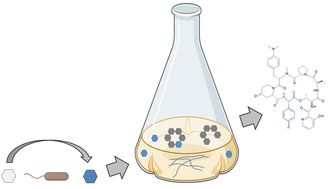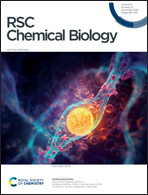Biotransformation-coupled mutasynthesis for the generation of novel pristinamycin derivatives by engineering the phenylglycine residue†
Abstract
Streptogramins are the last line of defense antimicrobials with pristinamycin as a representative substance used as therapeutics against highly resistant pathogenic bacteria. However, the emergence of (multi)drug-resistant pathogens renders these valuable antibiotics useless; making it necessary to derivatize compounds for new compound characteristics, which is often difficult by chemical de novo synthesis due to the complex nature of the molecules. An alternative to substance derivatization is mutasynthesis. Herein, we report about a mutasynthesis approach, targeting the phenylglycine (Phg) residue for substance derivatization, a pivotal component of streptogramin antibiotics. Mutasynthesis with halogenated Phg(-like) derivatives altogether led to the production of two new derivatized natural compounds, as there are 6-chloropristinamycin I and 6-fluoropristinamycin I based on LC-MS/MS analysis. 6-Chloropristinamycin I and 6-fluoropristinamycin I were isolated by preparative HPLC, structurally confirmed using NMR spectroscopy and tested for antimicrobial bioactivity. In a whole-cell biotransformation approach using an engineered E. coli BL21(DE3) pET28-hmo/pACYC-bcd-gdh strain, Phg derivatives were generated fermentatively. Supplementation with the E. coli biotransformation fermentation broth containing 4-fluorophenylglycine to the pristinamycin mutasynthesis strain resulted in the production of 6-fluoropristinamycin I, demonstrating an advanced level of mutasynthesis.



 Please wait while we load your content...
Please wait while we load your content...